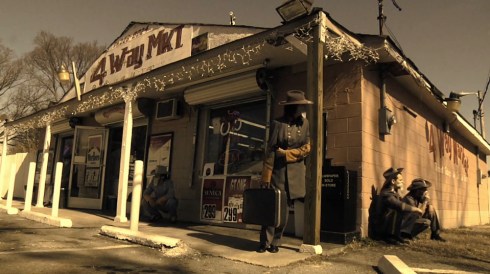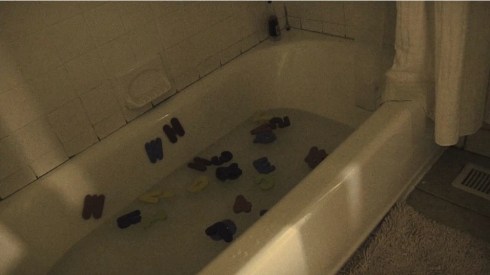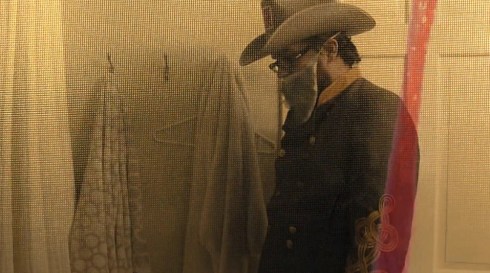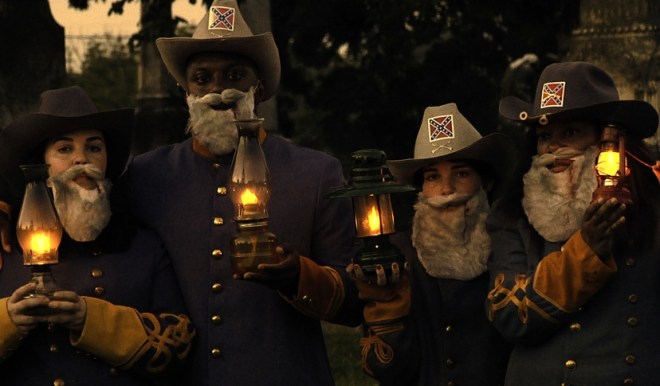By Rei Terada|
i.
In Pope.L’s film Reenactor (2012), a continuous loop of almost six hours in its longest version, actors in Confederate uniforms and Robert E. Lee fake beards circulate through ordinary spaces in Nashville (Fig. 1). Almost everyone is costumed in this way–children and animals generously excepted, the occasional stranger wandering in. It’s clear that this condition is different in various instances. Instead of Robert E. Lee and non-Robert E. Lee positions, there are various, sometimes incommensurable Robert E. Lee positions. References to reflection indicate coerced identifications involving the “I”–the narrator of the film’s voiceover–the “you,” and the viewer, as Pope.L’s very premise that black and white actors in the film must be dressed as Lee already suggests. A young black woman who is present for much of the film’s screen time, and narrowly eludes becoming a protagonist, works at a bourgeois restaurant fashioned as a Victorian house. She stands around in the corners, dressed in her Confederate uniform and beard, and listens to her co-workers emoting about U.S. soldiers, “young people you know getting killed in Kandahar.” As she literally drags a heavy piece of baggage–an unwieldy suitcase–across the streets and highwaysides of Nashville, as some kind of Robert E. Lee the viewer observes her.
 Fig. 1
Fig. 1
Documentary footage of Civil War reenactments in New Jersey and Pennsylvania extends the reenactment from Pope.L’s visual device to a profilmic reality. In these scenes the camera hovers close over the battleground where “dead” Confederate soldiers lie breathing. It isn’t clear what it takes to hold a border between past and present–or who wants to defend it. As the contrarian historian Constantin Fasolt observes,
…the distinction between past and present is doubtful in the extreme . . . . [E]xamples of some points in time where one could try to draw the lines . . . have something to recommend themselves. But only for some people and only for some time. None can claim to represent the line dividing the present from the past. If the present could really be divided from the past at all, it would have to be divided by as many lines as there are present moments: not one line between one present and one past, but an infinity of lines between an infinity of presents and an infinity of pasts, one for each incremental movement into the future. [1]
For Pope.L, there is never an option to benefit from the drawing of a historical line. At one point, Pope.L’s voiceover in a banal hotel or shopping center lobby describes the vertigo of “stop[ping] and look[ing] at history”–a kind of “infinity of lines”–and the vertigo of not stopping:
When you take the time to stop and look at history, you never know when it will end– suddenly, just like that, you’re in it, swimming, dreaming, floating, upside down; every sense of direction is just another layer and you ask yourself, how long have I been here gazing into this water? how long have I been here staring at my reflection? how long have I been turning to you, turning the pages of this ponder, dressed in this wonder? And you turn to me . . . laughing, punching my uncertainty, and I tumble out into the frozen floes of aisles, the mirrored lobbies, stumbling out, out, out, onto the streaming sidewalk, completely disoriented, into oncoming traffic. [2]
Pope.L reflects on a Fanonian claustrophobia of masks that cannot come off and malignant “you”‘s interiorized within the “I”: “you ask yourself, how long have I been here,” says the I, turning from his reflection to an “out” that is all mirrors. While stopping to “look at history” means “floating” in violence, the “I” is exposed to oncoming traffic after he is cajoled– driven?–from his hyperchronia. Establishing an outside is not an enlightenment path.
If the blackness of Pope.L’s narrator consists in the absence, for him, of an advantageous orientation, what is the racial anxiety of the internalized “you” who “punch[es] [his] uncertainty” and seems to hustle him into the street? Reenactor keeps marking this contrast. In it, a criticism of Reenactor that we might anticipate from previous discussions of totality and paranoia–that such scenes cultivate political indecision [3]–appears within the frame already as the voice of an internal persecutor. The soundtrack replays a white toddler’s voice calling “Wake up, wake up.” She has been seen nudging her Robert E. Lee parents, asleep in their uniforms, out of bed, and perhaps she, or someone, might say the same on the battlefield, “Wake up.” Her parents are as “asleep” as the Confederate reenactors are “dead”; so what counts as waking up–the “true” end of the war? Who would declare it? Can her parents really wake up now? Is there anything else besides calling on them to be woke?
By declining to divide historical from visual experience, Reenactor renders perception a political question and finally, maybe, a question of the limits of the political. To think about how this is so, we might ask how to process Reenactor beside the conversation on totality and paranoia still growing in the wake of Fredric Jameson’s notion of “cognitive mapping.” Jameson’s classic 1988 essay promises to derive strategic priorities from empirical surveys of structures and conditions, arguing that the apprehension of everyday spatiotemporal coordination as such entails a grasp, not of social totality, but of the shape of the “gap between phenomenological perception and a reality that transcends all individual thinking.” This logic continues to ascribe a commonly accessible “spatial analogue” of social understanding (353), even if that understanding is negative and focused on its own limitations. Contemporary versions of the idea still have a hard time addressing the limits of perceptual capacity with more than good intentions. [4] Léopold Lambert notes that in cognitive or forensic projects “the surface of the earth itself can be considered as a photographic surface from which evidences can be collected.” And he continues, pushing the logic to its limit, “although photographs’ degree of incrimination varies depending on what they actually show, it would . . . be a mistake to assume that some images constitute evidence when some others do not in the case of geopolitical criminality.” [5] (Lambert notes that he learns this point partly from Antonioni’s Blow-Up (1966)). Agreeing with Lambert on the saturation of crime, Reenactor suggests, by making it difficult to prefer any figure or location to another, that it takes something other than conscious effort to perceive a really saturated crime like U.S. slavery. The evidence is on the lens and in the camera as well as in the frame. Thus the urgency to hurry past the vertigo: a loss of standpoint incurs loss of status, damage to one’s worldly direction and own public worth. Jameson is right that competence in grasping spatiotemporal coordination is bound up with what counts as social and historical competence, which is why Pope.L notes the political deployment, the orthopedics, of competence. [6]
Jameson’s highlighted example of this competence in 1988 is the spatiotemporal grasp of Boston urban planning. He moves through the entire example without mentioning race, abjecting unfortunates who fall short of a “successful negotiation of urban space.” [7] Jameson relies instead on urban planner Kevin Lynch, author of The Image of the City (1960). For Lynch, downtown Boston “with its monumental perspectives, its markers and monuments,” cultivates its residents’ sense of “successful and continuous location” more profoundly than that of a less architecturally “traditional” city. In this deracinated view, the city that exemplifies spatial clarity and capacity in “Cognitive Mapping” is the segregated and territorial Boston of 1960. I lived there in 1988, the year that Jameson was citing Lynch, and found nothing intuitive or enabling about the self-congratulatory “public” rhetoric of its thoroughfares. “Cognitive Mapping”‘s unreflective sense of cognitive incompetence is mitigated, but still there in The Geopolitical Aesthetic: Cinema and Space in the World System, in which industrialization and deindustrialization are assumed to be the great divides in the U.S. and the “protagonist” there is “someone who blunders into” conspiracy “just as anyone might have done.” [8] All of this is in tension with Jameson’s stance in The Political Unconscious, which underscores the strangeness of the plain. Would Lynch and Jameson have seen differently if they had been able–as a positive capacity–to lose some of their spatiotemporal “competence”? It is not that Lynch chose wrong or incomplete data, but that antiblack fantasy immerses his method.
The “floating” that Reenactor instead explores visually and thematically evokes a missing category that would group together “present” and “past” to register the ongoing activity of slavery. The ancient philosophical idea of a single category for happening–in which what has happened keeps happening–still possesses stakes. Afro-pessimism’s insistence that racial slavery is an ongoing activity that shapes what counts as history more than the other way around provides a sharp phrasing of these stakes. Positioning slavery spatiotemporally activates the question of who gains from placing it where. But, further, Pope.L’s experiment indicates a different tension, a non-dialectical antagonism, that sets the politics of placing it anywhere at all at a remove from Reenactor‘s narrator.
Saying that images in Reenactor are dense to the point of repleteness, then, does not propel them into the land of celebratory aesthetic indetermination, as one might suspect if one sees “dreaming, floating, upside down” as recreational rather than lethal. Rather, it recognizes that any perception is exposed to antagonisms to the extent that it does not locate a place for itself amid agreed-on spatiotemporal axes. What can appear pejoratively as “confusion” registers as yet uncontrolled conflicts. A perception that has low political value because it cannot generate a clear direction for the political program already chosen indicates the fluctuating limits of that politics. It may instead present or evoke a density of tensions or a weight of effects that the perceivers cannot choose and/or do not wish to throw off.
Further, the tensions and effects can exceed the efficiency of political and economic means. What remains possible is not nothing, nor necessarily less than the political, but is not weighted down by its presumption. Critical debates about the “paranoia” of location signal the limits of the concept “totality” by naming its nimbus paranoia: where totality is no longer able to answer to political desire, Jameson suggests in both “Cognitive Mapping” and “Totality and Conspiracy,” paranoia steps in to fulfill the desire in fantasy. While the concept of totality is seen not to measure up to political desire and need, critics assume either that it has to be honed further to measure up or replaced with a more political concept. The possibility that the limits of the political too are being felt does not arise. Toscano’s remark that “it is isolation from political collectivity that, at one level, explains the epistemology of conspiracy” continues a line of thought that leaves no place for black dissatisfaction with the political as such, as has been expressed in iterations from Robinson to Wilderson to Reenactor. [9]
ii.
In Pope.L’s film, where the saturation of everyday violence is the default, forms that give the semblance of regularity to society are deflated. The pressure has already punctured art formalism, and the universal distribution of the Robert E. Lee costume indicates a similar fate for political forms such as the worker and the people. In Reenactor art formalism appears as formlessness or empty formality. So, Pope.L occasionally uses colored filters and inverted frames, but their appearance only shows that standard colors and orientations are equally discomfiting. The bathtub of the Robert E. Lee-couple’s toddler, dotted with her flotilla of alphabet toys, appears both right side up and upside down without inducing any change of mood or focus (Figs. 2-3).
 Fig. 2
Fig. 2
 Fig. 3
Fig. 3
Low contrast is not the same as low intensity, and intensity in Pope.L in general is difficult to characterize. Pope.L is anti-melodramatic, humorous, and ironic in his continuous dwelling in horror and disgust, yet it is still horror and disgust.
 Fig. 4 superimposition of fuchsia
Fig. 4 superimposition of fuchsia
Instead of high contrast there is “fuchsia.” Pope.L has been interested for a long time in this off-center shade of red, sometimes a vivid red-violet, sometimes a watery former crimson. “Circa, 2015” (2015), for example, consists of twenty-four fuchsia-including paintings of the word “fuchsia” spelled variously and paired with a different word. Fuchsia appears streaked across frames of Reenactor, trickles in the gutters and goes down the municipal drain; it seems to have soaked the uncanny red bread handed around by waiters at one of Nashville’s “Meat & Three” restaurants. Of course it evokes diluted blood, as though long-running blood were tired of running. In Pope. L’s Milk Pour (1999), gallon jugs of white liquid dumped in the gutter have a similar inability not to be milk even though the liquid is treated like, and comes to look like, soap scum.
Semantic and semiotic marks step into Reenactor as though their point was to limit the spatiotemporal anorientation and aesthetic formlessness, but they are only the congealed versions of the same anxiety. They do outlast organic bodies, with the result that they are the most decrepit entities. A crystallization of this crudity is the puppet play to which Reenactor intermittently returns, featuring dialogues with Robert E. Lee’s horse, Trigger (“Who is Robert E. Lee? Who is Robert E. Lee?”). Here, the classical harmonies are observed at the cost of rendering the figures literally wooden. The narrator does not break in to interpret what is already a philosophical dialogue in the Cartesian theater. But the puppet figures are almost completely reified sign-bodies and grotesque objects of pathos. This is a satire on the unities as settings fit only for stick figures–although these figures, like animations of language, do exist, struggle, read and create Civil War history, and ask the philosophical question, “Who is Robert E. Lee?”
As liquidity or crudescence, across a variety of experiments, what gets thrown down the drain won’t go away. In White Baby (1992) Pope.L. appears before an audience dragging a doll: “I do not like it, yet I am tied to it.” Exceeding duality and splitting integrity, name and thing pose blackness as enigma, misconstrued as label or role, as vanquished by disuse or transcendable by avoidance. Thus Pope.L constructs installations in which “processed foods such as mayonnaise, hot dogs and Pop Tarts seem to laugh in the face of anyone who believes that they might decay naturally,” [10] and black and white painted onions remain black and white while they rot. Fuchsia is not only diffuse blood but old blood, and diffusion runs to congealment, accumulation, and then to decomposition again. Criticism tends to cast decomposition as a matrix where things and thoughts can be recreated and slide gratefully from transformation to transformation–everyone wants this “rich and strange” fluidity of self-undoing. In Pope.L the teleology does not appear from here, and so the possibilities of unintegration for better and for worse are unlimited.
As Donna Jones notes in The Racial Discourses of Life Philosophy (2010), art criticism has often turned to Bergson for a counter-model of time that emphasizes simultaneity in duration. [11] Bergson stresses the almost infinite capacity of the past to preserve itself. In this his philosophy might seem to be poles away from cognitive mapping’s legibility. As Jones points out, however, in Bergson “confusion” is fusion; duration is a whole which he imagines a “whole soul” synthesizing in “free decision.” [12] In this way, Bergson demands another kind of competent self able to synthesize history inside itself. Jones aptly compares Bergson’s view of accumulation in continuity to “acquired wealth” (109), and, further, worries that Bergson “does not clearly guard against a biologically reductionist reading” of how consciousness assimilates the whole (104). Bergson’s whole self attuned to the holism of duration bursts through the defensive “crust” of givens (106), and confusion proves to have been only the superficial signal of a radiant singular shape. This might be a description of the interior cosmos that Civil War re-enactors could endorse, those who find the experience deeply integrative.
In Pope.L’s film, though, there seems to be no such reenactor. Reenactors on screen seem bored, inattentive, and since the concept is expanded, they are usually not aware that they are reenacting; reenactment is visible from the outside, however, as the normative force of U.S. society. There is no event of emergence and no project of recovering lost strata: “Profundity when you spread it out real thin has a texture like matzo and a sustenance like looking at it. It has a taste like red dye number two,” the narrator observes. There is, instead, everyday anorientation. Perception must return from seeking the real to the dilemmas of its constitution, which do not, for the narrator, include a direction to take. This is why Reenactor includes an homage to the Tropicalia constructivist Lygia Clark’s performance Caminhando (1963), which merely instructs the artist–or anyone else–to scissor down the middle of a Möbius strip until it’s too narrow to cut any more.

Fig. 5
It is not to extract the truth but to persist in being that, as Reenactor’s narrator avers, “there is only one kind of history, the cut.”
Notes and Citations
[1] Constantin Fasolt, The Limits of History [Chicago: U of Chicago P, 2004), p. 10, my italics.
[2] Reenactor, dir. Pope.L. 2012 (recut 2014 and 2015), 2015 version screened at the Museum of Contemporary Art, Los Angeles, 2016.
[3] Alberto Toscano and Jeff Kinkel, for example, associate a “panorama of unbounded collusion” with political despair. See Cartographies of the Absolute (Winchester, UK: Zed Books, 2015), p. 75.
[4] Jameson knows that the “mental map of the social and global totality we all carry around in our heads” is “variously garbled” and wants a society without hierarchy, but the criteria of mapping generate both a normative practice and a hierarchization of “successful” and “crippled” political subjectivities.
Similarly, Adam Rothstein’s pause to acknowledge that “infrastructural research does not claim to be the last word” offers only supplemental good faith (Rothstein, “How to See Infrastructure: A Guide for Seven Billion Primates,” Rhizome, July 2, 2015). Citing Donna Haraway’s concern about mythologies of science, Rothstein promises that the infrastructural knowledges he desires “do not attempt to be everything, but never forget what they are and where they got their material.” How is it possible to be confident in the claim that the self is in charge of what it forgets? The article basically assumes that people who have read Haraway and mean well will do fine.
[5] “The Continuous Coincidence of the Crime and the Photograph,” The Funambulist, July 27, 2015.
[6] Pope.L’s text “Hole Theory” observes, “this theory / Could only come from someone / Who lacks something / As a political condition.” It supports lack, making the connection between political competence and disability that has “the courage / To move about in the world / Bumping into things, / Narrowly missing things, / Trying to get things done / In the fact of what might seem, / To a sighted person, / An obvious life-limiting lack . . . .” In William Pope.L.: The Friendliest Black Arist in America, ed. Mark H.C. Bessire (Cambridge, MA: MIT Press, 2002), pp. 83, 85.
[7] The phrase “successful negotiation . . .” is from Colin McCabe’s introduction to The Geopolitical Aesthetic, p. xiv.
[8] The Geopolitical Aesthetic: Cinema and Space in the World System (Bloomington: Indiana UP, 1995, p. 34).
[9] Martin John Callahan, Alberto Toscano, Sarah Brouillette, and Tom Eyers, “Paranoid Subjectivity and the Challenges of Cognitive Mapping–How is Capitalism to be Represented”,” E-flux, March 2015, unpaginated. See Cedric Robinson’s critique of “politicality” in Terms of Order: The Myth of Political Leadership, 2nd ed., ed. Erica R. Edwards (Chapel Hill: U of North Carolina P, 2016); Frank B. Wilderson III, Red, White, and Black: Cinema and the Structure of U.S. Antagonisms, especially Chapter Two (Durham: Duke UP, 2010), pp. 54-91.
[10] Mark H.C. Bessire, “The Friendliest Black Artist in America,” in William Pope.L: The Friendliest Black Artist in America , ed. Mark H.C. Bessire (Cambridge, MA: MIT Press, 2002), p. 25.
[11] Donna V. Jones, The Racial Discourses of Life Philosophy: Negritude, Vitalism, and Modernity (New York: Columbia UP, 2010), p. 105.
[12] Henri Bergson, Time and Free Will: An Essay on the Immediate Data of Consciousness, 3rd. ed. [1913], trans. F.L. Pogson. Minneola, NY: Dover, 2001, p. 171.
